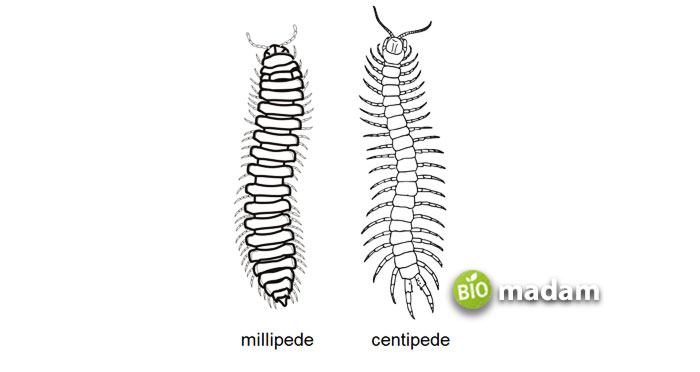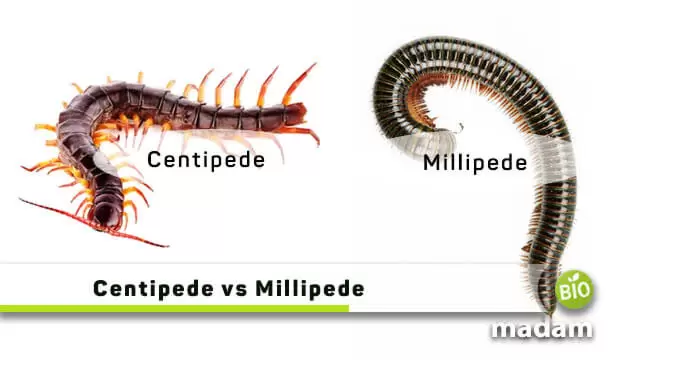Centipedes and millipedes are creatures that seem to have similar characteristics due to being in the same group but are different from each other. They are from the group Myriapoda, coming from the four classes of arthropods. We cannot call these species true insects, nor are they arachnids, and most closely resemble lobsters, crayfish, shrimps, and prawns.
Either its centipede or millipede, both acquire segmented bodies living in moist habitats or areas of high humidity. As said earlier, besides the several similarities, these creatures are distinct from each other. Let’s start with a comparison chart to get a brief idea of the differences between them.
Comparison Table
| Parameters | Centipede | Millipede |
|---|---|---|
| Movement | Fast-moving | Slow-moving |
| Structure | Flat & Flexible | Cylindrical |
| Ability to Bite | Yes | No |
| Type of Organism | Carnivores | Scavengers |
| Eggs Laid | 40 to 50 | Up to 300 |
| Segments/ Divisions | 15 to 100 | 11 to 150 |
| Body Color | Yellowish, Greyish, Reddish Brown | Dark Brown or Black |
| Length | 4-12 inches | 1-8 inches |
| Poisonous | Yes, Most of them | No |
| Legs | Long | Short |
What is Centipede?

Centipedes belong to the class Chilopoda, which are flat, elongated, and segmented bodies. These structures consist of pairs of long legs on every 15 or more of their trunk segment. The word centipede was originated from a Latin prefix, “centi,” meaning “hundred,” and “pedis,” meaning “foot.” They are considered to be the oldest animals on planet Earth. Biologists usually pronounce them from their common name, “hundred-legged worms.”
When considering their niches and habitat, these creatures demand a moist environment due to the lack of waxy epicuticles. Furthermore, centipedes are born with several colors and beautiful patterns, where the traditional ones are grayish, brown, and reddish-orange. On the other hand, some underground centipedes have no specific color due to a lack of pigmentation.
Types of Centipedes
There is a vast arthropod variety in centipedes as follow:
House Centipedes: Night hunters, Scolopendra gigantea is an example of house centipede found in tropical and subtropical forests in northern South American.
Amazonian Giant Centipede: This large, fearsome, predatory arthropod with highly toxic venom can quickly kill arthropods. Scolopendra gigantea is also an example of an Amazonian giant centipede.
Texas Redheaded Centipede: Large centipede with 20 to 21 pairs of legs appears dark-brown with a redhead. They can grow up to 8 inches. Scolopendra heros is an example of these centipedes.
Stone Centipedes: mostly live under logs and rocks. An example of a stone centipede is Lithobius forficatus found in Europe.
Soil Centipedes: they dig the soil like earthworms by alternately expanding and contracting the body.
Aquatic centipede: Scolopendra cataracta called waterfall centipede.
What is Millipede?
This creature belongs to the Diplopoda, a special class within Arthropods of the subphylum Myriapoda. They are characterized by having two legs (or four legs total) per body segment. Moreover, millipedes come with 11 to 100 trunk segments derived from an embryological and evolutionary fusion of primitive metameres. That is the reason they have pairs of appendages per body segment. The common name of millipedes is thousands-legged worms. There are around 7,000 millipede species globally, but most are found in America and North Africa. Regarding leg pairing, they have as many as 22 (11 pairs) to 750 (350 pairs), and their length range is 2 to 280 mm. The extended legs position is only slightly laterad, partially visible to the body’s side (short legs), supporting millipedes, and taking off more substrate.
Common Millipedes’ Species
Out of a wide variety of such species, we have enlisted a few below:
- Cylindroiulus Caeruleocinctus
- Tachypodoiulus niger (White legged Snake Millipede)
- Ommatoiulus sabulosus (Striped Millipede)
- Archispirostreptus Gigas (Giant African)
- Narceus americanus (American Giant)
Differences between Centipede and Millipede

There appear numerous differences between the two species of Myriapoda, which are as follow:
Number of Body Segments
Centipede
A single centipede’s body is divided into almost fifteen to a hundred segments with a single leg pair in each segment.
Millipede
On the other hand, a millipede has a minimum of 11 segments that can extend to 150. Furthermore, they seem to have two leg pairs in each body segment.
Structure
Centipede
This creature is generally flat in structure with a dorsoventral body.
Millipede
On the contrary, a millipede is seen as cylindrical.
Body Color
Centipede
There are different body colors of a centipede, with greyish, yellow, or reddish-brown being the common ones.
Millipede
Similarly, millipedes are traditionally black or dark brown.
Variation in Legs
Centipede
All the centipedes grow with extended legs to the body sideways.
Millipede
Comparatively, millipedes have shorter legs that do not further extend from the body.
Variation in Body Length
Centipede
These animals are larger than the millipedes, with lengths ranging between 4 and 12 inches.
Millipede
On the contrary side, millipedes are smaller, varying from 1 to 8 inches.
Number of Eggs Laid at a Time
Centipede
On average, if we observe, a female centipede can lay up to 40 to 50 eggs at a time.
Millipede
In contrast, these female species lay six times more eggs than a centipede, 300 eggs.
Speed/Movement
Centipede
Centipedes are a pretty fast species.
Millipede
On the other side, millipedes are quite slow in moving.
Type of Organisms
Centipede
These are naturally carnivores, feeding on smaller organisms to live.
Millipede
They are scavengers, depending on the dead and decayed matter to survive.
Conclusion
We tried to provide you the all the differences between a centipede and a millipede in a detailed manner. There could be many similarities among the two, but that’s mostly due to their almost similar appearance. Otherwise, the two species of the group Myriapoda are entirely different in nature.

Hello, I would like to introduce myself to you! I am Chelsea Rogers, an experienced blog writer for science articles, holding an MPhil degree. My enthusiasm to grab the best knowledge, let it relate to botany, zoology, or any other science branch. Read my articles & let me wait for your words s in the comment section.

